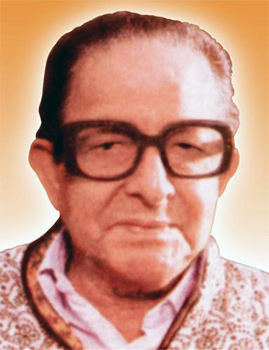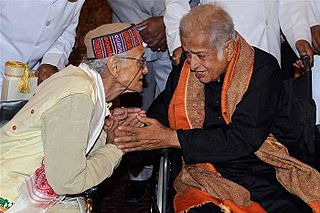
The Asam Sahitya SabhaAssamese pronunciation:[/ɔxɔmxaɦittjɔxɔbʱa/]; lit. 'Literary Society of Assam') is a non Government, non profit, literary organisation of Assam. It was founded in December 1917 in Assam, India to promote the culture of Assam and Assamese literature. A branch of the organisation named Singapore Sahitya Sabha was launched in Singapore on 28 July 2019.

Homen Borgohain was an Assamese author and journalist. He was awarded the 1978 Sahitya Akademi Award in Assamese language for his novel Pita Putra. He was also the President of Assam Sahitya Sabha from 2001 to 2002.

Nabakanta Barua was a prominent Assamese novelist and poet. He was also known as Ekhud Kokaideu. As Sima Dutta he wrote many poems in his early life.

Prof Bhabananda Deka was a pioneer Assam economist and author who conducted novel research on the economy of the far eastern part of India. He was also a leading Indian-Assamese litterateur of the famed 'Awahon-Ramdhenu Era' of Assamese literature during the mid-20th century. He was the author of a total of 115 English and Assamese books including textbooks on a range of fifteen subjects including economics, ancient Assamese literature, philosophy, education, religion, mythology, archaeology, tribal study, poetry, drama, memoirs, civics, political science, biographies; he also edited books and journals. He also authored a variety of research papers and articles about the state of Assam, a state in the north-eastern part of India. He pioneered the writing of books on Economics in Assamese. His Assamese book Axomor Arthaneeti was the first ever research-based comprehensive book on Assam Economics, which was published for the first time in 1963. He was conferred with the honorary title of 'Asom Ratna' -- 'Jewel of Assam' by the intellectuals of Assam on 19 August 2007 at a public meet held under the presidency of Prof. (Dr) Satyendra Narayan Goswami.

Orunodoi or Arunodoi was the first Assamese-language magazine published monthly from Sibsagar, Assam, in 1846. The magazine created a new era in the world of Assamese literature and gave birth to notable authors such as Anandaram Dhekial Phukan, Hemchandra Barua, Gunabhiram Barua, and Nidhi Levi Farwell. The magazine took the initiative of innovating the then Assamese dialect instead of borrowing words from other languages. The Assamese people got to know about the western world only through this magazine, which opened the gate to the modern literacy in Assam. It mainly included various news related to current affairs, Science, astrology, history and also trivia although Christianity was its main aim. The magazine's publishing ended when the printing press was sold in 1883.
JonakiMoonlight was an Assamese language magazine published from Calcutta in 1889. It was also the mouthpiece of the then Assamese literary society Asamiya Bhasa Unnati Sadhini Sabha in which the society’s aim and objectives were regularly expressed. The first editor of the magazine was Chandra Kumar Agarwala.
Assamese is part of the easternmost group of the Indo-Aryan languages. History of Assamese literature can largely be classified into three periods, including: Early Assamese period, Middle Assamese period and, Modern Assamese.

Mahim Bora was an Indian writer and educationist from Assam. He was elected as a president of the Assam Sahitya Sabha held in 1989 at Doomdooma. He was awarded most notably the Padma Shri in 2011, the Sahitya Akademi Award in 2001 and the Assam Valley Literary Award in 1998. Assam Sahitya Sabha conferred its highest honorary title Sahityacharyya on him in 2007.He also participated in the Quit India Movement of 1942 held in Kaliabor town in the Nagaon district of Assam.

Imran Shah, also known as Nawab Imran Shah is an Indian Assamese language writer, poet, novelist, and scholar. He also writes under the pen names Ishan Dutta, Anamika Baruah, Kumbhakarna, and Animesh Baruah. The Government of India awarded him the fourth highest civilian honour of the Padma Shri, in 2021, for his contributions to literature and education.
Raghunath Choudhary (1879–1967) was an Indian writer of the Jonaki era or the romantic era of Assamese literature. Choudhary is known as Bihogi Kobi because most of his writings are based on birds and nature. Choudhary also took part in the Indian independence movement and was imprisoned by the British for the same. He was the president of Tezpur session of Asam Sahitya Sabha in 1936. Kamrup Sanjeevani Sabha conferred him with the title Kabiratna.

Hemchandra Goswami (1872–1928) was an Indian writer, poet, historian, teacher and a linguist from Assam in the early part of modern Assamese literature. He was the fourth president of the Asom Sahitya Sabha in 1920 held at Tezpur. He retired as Extra Assistant Commissioner in the British Assam.

Chandra Kumar Agarwala was a writer, poet, journalist from Assam. He is a pioneer of the Jonaki Era, the age of romanticism of Assamese literature. Agarwala was titled as Pratimar Khonikor in Assamese literature. Agarwala was the first editor and financer of the Jonaki magazine and a founder member of Asamiya Bhasa Unnati Sadhini Sabha, a literary organization of Assam with his intimate friends Lakshminath Bezbarua and Hemchandra Goswami. Agarwala, along with his friend Lakshminath and Hemchandra, are known as "Trimurti of Assamese literature" for their remarkable contribution to the very beginning of modern Assamese literature. Chandra Kumar Agarwala was the brother of writer and poet Ananda Chandra Agarwala and uncle of Jyoti Prasad Agarwala, a noted poet, playwright, composer, lyricist, writer and first Assamese Filmmaker.
Ananda Chandra Barua (1907–1983) was a writer, poet, playwright, translator, journalist and actor from Assam. He is popularly known as Bokulbonor Kobi in Assamese literacy society. He was honoured with, most notably the Padma Shri title and Sahitya Akademi award.
Bhubanmohan Baruah was a novelist, short story writer from Assam. He wrote many novels under the pen-name of Kanchan Baruah.
Sarat Chandra Goswami (1887-1944) was a prominent writer of Assam who enriched the Assamese literature with his short stories. Goswami was a founder member of Asam Sahitya Sabha and elected as a Secretary of the Sabha for the first time. He continued in the same post from 1920 to 1927.

Nilmoni Phukan (1880–1978) was an Assamese writer, poet, freedom fighter and politician popularly known as Bagmibor in the Assamese literature. Since he shares his name with another Assamese poet, Nilmani Phukan, he is often referred as Nilmoni Phukan (Senior). Phukan was the president of the Asam Sahitya Sabha for two times; in 1944 held at Sivasagar district and in 1947 held at Dibrugarh district of Assam.

Professor Maheswar Neog was an Indian academic who specialised in the cultural history of the North East India especially Assam, besides being an Assamese-language scholar and poet. He was a top Indologist, and his work covers all disciplines of Indian studies, folk-lore, language, dance, history, music, religion, drama, fine arts, paintings, historiography and hagiography, lexicography and orthography, epigraphy and ethnography. His research includes multi-dimensional features of Vaishnava renaissance in Assam through Srimanta Sankardev, Madhabdev, Damodardev, Haridev, Bhattadev and other Vaishnava saints of Assam.











